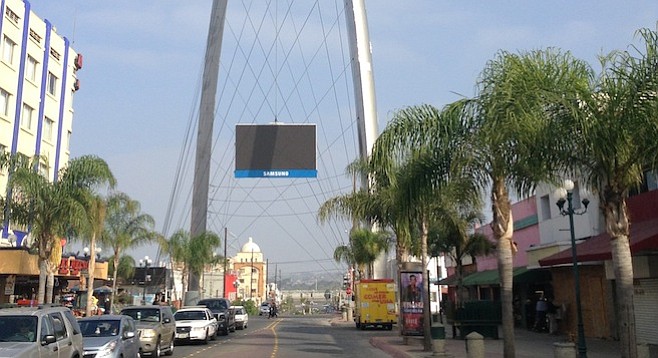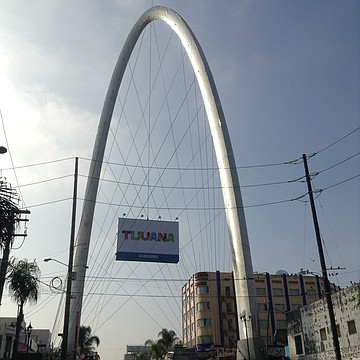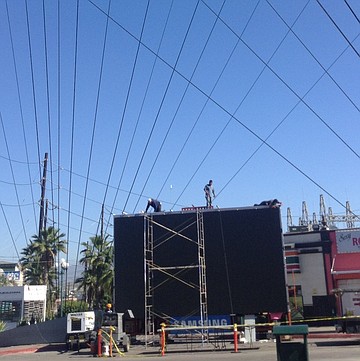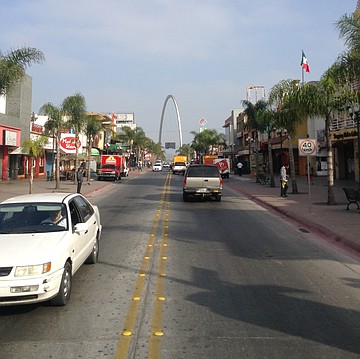 Facebook
Facebook
 X
X
 Instagram
Instagram
 TikTok
TikTok
 Youtube
Youtube

El Arco Monumental de Tijuana is a similar structure to the Gateway Arch in St. Louis, but a quarter of its size and with a hanging clock. Its official name is “El Arco del Milenio” (“millennial arch”) and is also known as “el reloj” (“the clock”), though some locals say that the clock stopped working a week after its installation.




The mayor at the time — now Baja's governor, Francisco “Kiko” Vega — commissioned the arch in 2001 and it never got much upkeep. The arch had a Mexican flag and a “Bienvenida a Tijuana” banner on the north end; the south end had the non-functional clock. State and city shields were at both ends. With the passing of time, the clock became a rectanglular six-ton block of ugliness. It was taken off the arch in early January of this year.
On Saturday, February 14, a giant LED screen composed of 80 small monitors was mounted facing the south side of the arch (the north side has the logo of Tijuana's 125th anniversary). The screen also serves as an advertisement for Samsung, one of Tijuana's big maquilas. The screen has not been powered yet, but sources say they expect it to be functioning within a week. The screen will broadcast government messages as well as local concerts and sporting events (like Xolos soccer matches).
The arch is located at First Street and Revolución, “the heart of Tijuana,” and can easily be seen from the U.S. side. I walk under the arch on a regular basis, so I was able to witness when the test images were being shown. A snowboard video was being displayed, and the HD quality was great, unaffected by the bright sun.
Whenever I see a lost or confused tourist near the border, I always tell them to head toward the arch; this is where downtown TJ begins. Once you get to the arch, if you head north you enter Zona Norte, the "tolerance zone" where anything can happen (be careful); if you go south, you are walking the main downtown street locals know as “Revu.”
The arch’s update was brought on by the efforts of the secretary of tourism and Tijuana's mayor, Jorge Astiazarán. Astiazarán was recently quoted by media as saying, “Downtown Tijuana is ugly, stinks, and is full of garbage,” which angered locals. City workers with bright-colored shirts have been sweeping the streets regularly since Saturday.
Tijuana’s daily Frontera says the screen measures 35 meters (about 115 feet) but does not specify if the measurement is of its diameter, the diagonal, or its length or height.


El Arco Monumental de Tijuana is a similar structure to the Gateway Arch in St. Louis, but a quarter of its size and with a hanging clock. Its official name is “El Arco del Milenio” (“millennial arch”) and is also known as “el reloj” (“the clock”), though some locals say that the clock stopped working a week after its installation.




The mayor at the time — now Baja's governor, Francisco “Kiko” Vega — commissioned the arch in 2001 and it never got much upkeep. The arch had a Mexican flag and a “Bienvenida a Tijuana” banner on the north end; the south end had the non-functional clock. State and city shields were at both ends. With the passing of time, the clock became a rectanglular six-ton block of ugliness. It was taken off the arch in early January of this year.
On Saturday, February 14, a giant LED screen composed of 80 small monitors was mounted facing the south side of the arch (the north side has the logo of Tijuana's 125th anniversary). The screen also serves as an advertisement for Samsung, one of Tijuana's big maquilas. The screen has not been powered yet, but sources say they expect it to be functioning within a week. The screen will broadcast government messages as well as local concerts and sporting events (like Xolos soccer matches).
The arch is located at First Street and Revolución, “the heart of Tijuana,” and can easily be seen from the U.S. side. I walk under the arch on a regular basis, so I was able to witness when the test images were being shown. A snowboard video was being displayed, and the HD quality was great, unaffected by the bright sun.
Whenever I see a lost or confused tourist near the border, I always tell them to head toward the arch; this is where downtown TJ begins. Once you get to the arch, if you head north you enter Zona Norte, the "tolerance zone" where anything can happen (be careful); if you go south, you are walking the main downtown street locals know as “Revu.”
The arch’s update was brought on by the efforts of the secretary of tourism and Tijuana's mayor, Jorge Astiazarán. Astiazarán was recently quoted by media as saying, “Downtown Tijuana is ugly, stinks, and is full of garbage,” which angered locals. City workers with bright-colored shirts have been sweeping the streets regularly since Saturday.
Tijuana’s daily Frontera says the screen measures 35 meters (about 115 feet) but does not specify if the measurement is of its diameter, the diagonal, or its length or height.
Comments